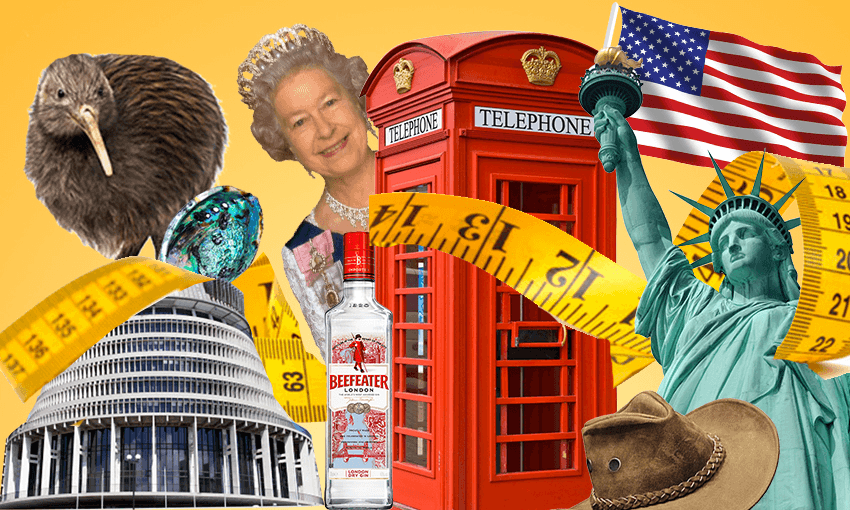The metric system might seem obvious to us, but resisting it has started to become a point of extreme pride for Americans. Can New Zealanders help save them? Elle Hunt investigates.
With Trump gearing up for his 2020 campaign amid ongoing investigations into Russian interference, it is the question on every honest American’s lips: can the US continue to stand alone against the metric system?
Earlier this month, the country’s fearless resistance of the existential threat posed by metres and grams was applauded on Tucker Carlson Tonight during an interview with James Panero, the executive editor of The New Criterion, a conservative culture journal. No, that’s not an oxymoron. It’s a publication that alternates between comparing Trump to “frank and manly” Pericles – master orator and general of Athens during its Golden Age – and scoring cheap points against minorities.
If your expectations of Fox News weren’t already many metres – sorry, yards – towards the earth’s core by now, you might think this earnest discussion of the “tyranny of the metric system” amusingly by-the-by when the US seems – at least from afar – to be in thoroughgoing crisis, from its government and civic institutions on.
But no. Not on – excuse me while I look this up – ”World Metrology Day”. (How did you celebrate? I had a BBQ.) “Against pascals of pressure, the US stands nearly alone in maintaining its ‘customary units’ of weights and measures,” wrote Panero in his highly necessary, eviscerating takedown of metrication in the Wall Street Journal.“We should stand tall on our own 2 feet,” he concluded – alongside Myanmar and Liberia, the two other countries that do not observe the metric system.
https://www.youtube.com/watch?v=8jl5epgqHac
The Fox segment is still worth a watch, because it is hilarious: Carlson’s waxy, po-faced expression, like a recalled Ken doll; Panero’s polka-dot bowtie, reminiscent of the one worn to the ball by the strangest boy at your high school, who was almost certainly studying classics; the gravity with which they approach the discussion above the banner: “IS THE METRIC SYSTEM COMPLETELY MADE UP?”.
And that is all to be had just from the paused video, before you get to Carlson’s reference to “the yoke of tyranny” and mispronunciation of “kilograms”. “Holy shit,” tweeted someone, “the video is 100x better than the still image ever could have led me to believe.” The interview is a rare moment of unproblematic comedy, but not without questions.
My first: in what world are these people living, that even the preference for quarts over millilitres – to most outsiders, merely vaguely irritating – can be held up as a triumph of American exceptionalism?
My second: can New Zealand show them the way out?
New Zealand started switching from the imperial system of measurement inherited from the UK to metric 50 years ago, with the establishment of the Metric Advisory Board in 1969. A multifaceted approach was taken to counter widespread suspicion and reluctance, including nicknaming a baby girl born in 1970 “Little Miss Metric” and reporting news of her development alongside that of metrication to give the switch a human face. A press release from 19 June 1975 made clear the impact on the national game: “What used to be the 25-yard line is now 22m from the goal line.” By 1976, the switch was mostly complete.
Though traces of imperial still remain in New Zealand, in the aviation industry and sometimes in giving height and weight, metrication has largely taken root, in a relatively short period of time. In fact a Broadcasting Standards Authority complaint, made in 2001 by one Mr Fortune, argued that the use of non-metric measurements by a television show called The Private Lives of Giants constituted deliberate flouting of the law. It goes to show that, within 30 years of its introduction, the metric system had become “part of our daily lives”, wrote then-consumer affairs minister Judith Tizard in December 2006.
Like the US, the UK, relatively, has struggled to adjust. In London, I have come up against stone, pounds, feet, inches, yards, acres. There have been moments when it has felt strangely freeing, like when I realised I truly had no idea of what I weigh; but many more when it has just been annoying, like when I was running a half-marathon and realised only at the perfunctory 10-kilometre notice that I had much further to go than I’d thought.
Britain’s preference for imperial persists despite the attempt made by the European Commission in 1995 to phase it out by 2009. In 2011, the supermarket chain Asda reverted to selling strawberries by the pound (a little over 450g – not quite 500g, though!) for the first time in over a decade after a survey found that 70% of customers found metric labelling confusing. Social historian Joe Moran told the BBC at the time that the British were reluctant to let go of the imperial system because tradition is reassuring.
That New Zealand was able to more or less cast off the old system in less than a decade reflects its readiness to embrace not only change and the future, but an identity of its own. Australia, Canada, South Africa and more recently Ireland also made the transition fairly smoothly. As chef Rick Stein said in 2011, “When people prefer to use imperial over metric, I believe they are saying the old times were better.” Wasn’t that what the Brexit vote was about, too?
As leery as I am of crediting Panero as the voice of the people – or really, any person – it may be that it is the same insecurities about “global revolution” that have got him clinging to his cups. “We have no reason to be ashamed for using feet and pounds,” says Carlson – but is it the “this weird, utopian, inelegant creepy” metric system the world’s fading superpowers are afraid of, or change in general?



